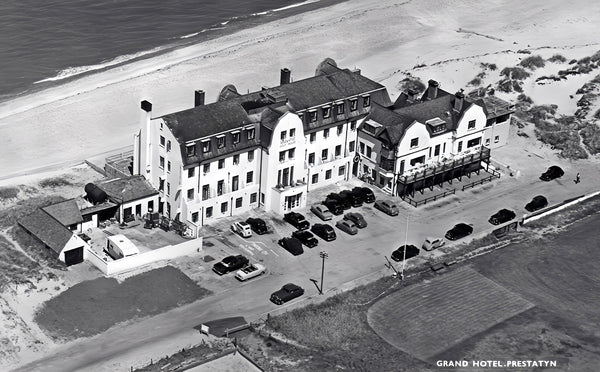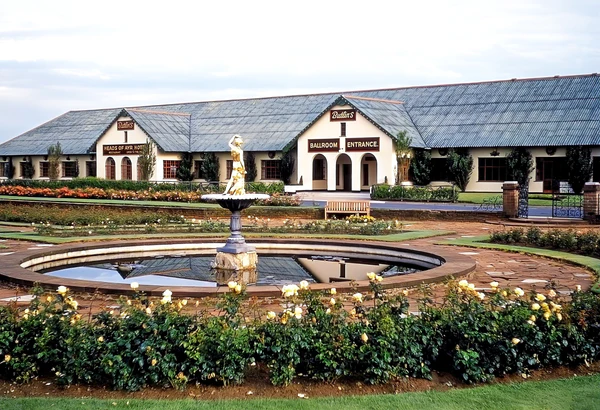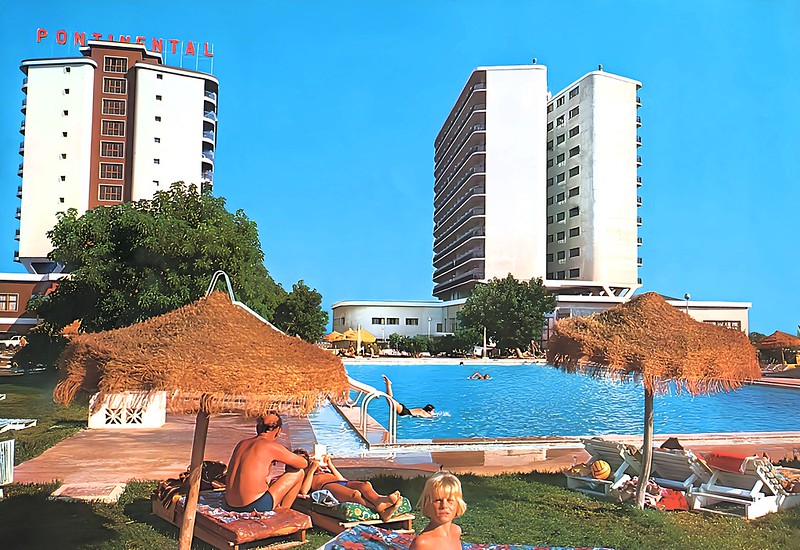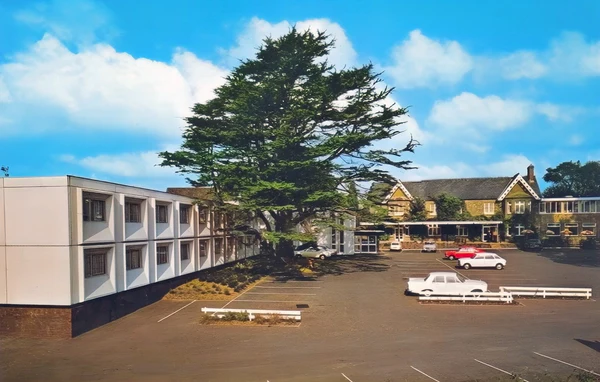Cliftonville was once the posh bit of Margate “the fashionable end of town” and boasted several grand hotels catering to upmarket visitors. During World War II many had been requisitioned for military use and at the end of the war the hotels had become rundown and the affluent visitors had moved on elsewhere.
Billy Butlin arrived in town in March 1955 and purchased 4 hotels from the loss-making Nicholson Hotel Group, managed by Cyril Nicholson. The hotels were the Norfolk, Florence, St George’s and Queen’s. He paid a nominal fee of £1,000, plus an agreement to take over the outstanding mortgages of £67,000. The hotels were given a quick refresh, during which the Queen’s caught fire. But the other 3 reopened for 1955 under the Butlins name and attracted 9,000 guests that first season, which represented a four-fold increase over the previous year.

The hotels operated year round and were all full board with 3 meals a day included. They had a lot of the usual Butlin facilities including redcoats, games rooms, bars and evening entertainment along with “paper mache roses and brightly coloured cardboard parrots”. Guests were allocated a particular hotel on booking and were free to enjoy the facilities at any of the others. Up to 80 redcoats would be resident each summer.
Throughout the rest of the 1950s Butlin went on to purchase 5 more hotels in the town, some of which were for staff use only whilst others were resold shortly after. He became a local hero and was credited with revitalising the town. Several local Councillors urged him to run for Mayor, something which Butlin was not keen on doing.
By the mid-1970s only 4 hotels were left and these remained under Butlins ownership until being sold in July 1999. Butlins said they were moving upmarket and the hotels no longer fitted in with their new image.
List of Butlins Hotels in Cliftonville

Norfolk Hotel, 200 bedrooms, acquired from Nicholson Hotels, owned by Butlins from 1955 to 1999, sold to the Grand Hotel Group, demolished 2005

Grand Hotel opened 1904 by Thomas Higgins as the Cliftonville Hydro Hotel. Had 110 bedrooms and was renamed the Grand in 1920. After the war it was acquired by boxer Benny Lee and sold to Buitlins in 1956. Owned by Butlins until 1999 then sold to the Grand Hotels Group, demolished 2005

St George’s Hotel, 280 bedrooms, acquired from Nicholson Hotels, owned by Butlins from 1955 to 1999, sold to the Grand Hotel Group, demolished 2007

The Norfolk, Grand and St George’s were next door to each other and around 1990 were connected by a 600ft underground tunnel which was the brainchild of hotels boss David Shelley. By the 1990s they were being marketed under one name – the Butlins Cliftonville Hotel. The dining room was usually located in one hotel so residents of the other two might have a lengthy walk through the tunnel.
Florence Hotel came as part of the Nicholson Hotel acquisition in 1955. Had 80 bedrooms and was mostly used as staff accommodation. Sold in November 1971 to Paul Singh and later converted into 31 self-contained flats known as Florence Court. Still standing today.

Carlton Hotel, 54 bedrooms, acquired 1959, later known as the Queen’s Carlton Hotel. Originally intended for young couples with babies and featuring “trained staff and qualified nurses”. Sold in November 1968 to the Inner London Education Authority. Converted into residential flats in the 1970s. Still standing today, now known as Carlton Mansions.

Prince’s Hotel. Acquired from the Gradus family in 1956. Only ever used for staff accommodation and offices. In 1993 an armed robber made off with £40,000 in wage packets for the staff. It was sold in 2004 and converted into 9 luxury flats and renamed Walpole Heights. Still standing today

Cliftonville Court Hotel – Owned by Edwin Carloss this 40-bedroom hotel went bankrupt in 1956 and was sold to Butlins later that year. It was resold in the early-1960s and converted into flats in 1965. Still standing today as Cliftonville Court.

Hurlingham Hotel – I can’t seem to find much information on this one. It was located on Surrey Road.
The Queen’s Hotel: A Notorious Legacy
This was originally several smaller hotels which were joined together in 1910. A new facade was built along the front making it appear like one big hotel but the view from the rear showed a hodgepodge of different buildings. Requisitioned during the war the hotel had remained closed ever since and was in a rundown condition. It was acquired as part of the Nicholson Hotels purchase in 1955.


It was undergoing an extensive rebuild and was due to be officially opened on 16th May 1955. But a huge fire 3 days beforehand destroyed the middle third of the building including the ballroom, Tudor dining hall and several guest rooms. Commenting on the fire Butlin said “we were rather unlucky with the fire but not so unlucky as the insurance company”
Over the next year the hotel was rebuilt and a new indoor swimming pool was constructed in the fire damaged section. The pool featured underwater viewing windows, an idea that was copied at Butlins Ayr in 1956, before appearing at all the Butlin camps.

The hotel was never a huge success and was sold by Butlins in November 1968 to Hoser’s Tea Gardens run by Harold Hoser and Sam Ridler. The hotel switched from full board to bed and breakfast and was renamed the Queens Motel Entertainment Centre. Various parts of the hotel were leased out to third parties.
In April 1969 the indoor pool was filled with sea water and became a dolphinarium with two dolphins named Britt and Turk performing 8 shows a day. A Waltzing Waters show was added to the theater for daytime shows while an Old Time Music Hall played during the evenings. Bunny girls were added to the bars.
In March 1970 it was sold to Louis Holloway who owned the nearby Fort Lodge Hotel. The Dolphins returned with the addition of 2 sealions (Sonny & Clyde). A new comedy show appeared in the theatre.
Later that year a model village was constructed outside on the site of the old skating rink. It was built in conjunction with Woburn Abbey and the official opening was performed by the Duke and Duchess of Bedford.

In March 1974 plans were put forward to demolish the hotel and replace it with a new 11-storey apartment block which a local Councillor described as a “monumental eyesore”. The plans were rejected.
The hotel closed at the end of 1974 but some of the complex remained open including the dolphin show and two nightclubs – Hippocampo and Bellamy’s. In 1976 new sex equality laws were introduced which meant the previous policy of letting women in free had to be scrapped. The management complained “With girls having to pay the full whack, their numbers are bound to decline – who wants to go to a club full of blokes?”.
The model village and dolphin show both closed at the end of 1976. That same year an indoor model railway opened featuring an HO-scale German layout, along with an under-18s alcohol-free disco. In 1977 an enforcement notice was served on the owners to clean up the ‘eyesore’ site.
New revised plans for the apartments were submitted which included seven x 8-storey blocks, which was rejected, and then eight x 6-sorey blocks to which a councilor stated “In no way is this committee going to agree with that abortion of a plan”.
The hotel was demolished in March 1979 but the site wasn’t cleaned up and remained full of rubble and weeds. It was then put up for sale and over the years many battles were fought while the site endured “years of deprivation and neglect” The 1980s came and went. It wasn’t until 1991 that construction was finally approved for two 3-storey blocks each containing around 60 flats.

Construction was complete by June 1992 but then the developers went bankrupt with debts of £1.3 million. Local tradesmen picketed the site demanding payment for goods and services. Alliance & Leicester Building Society, who had financed the construction, took over the project and to raise funds one of the blocks was sold to a housing association with the apartments being rented out to council tenants, much to the dismay of some local residents.



